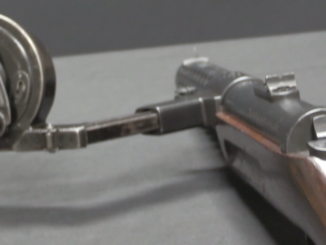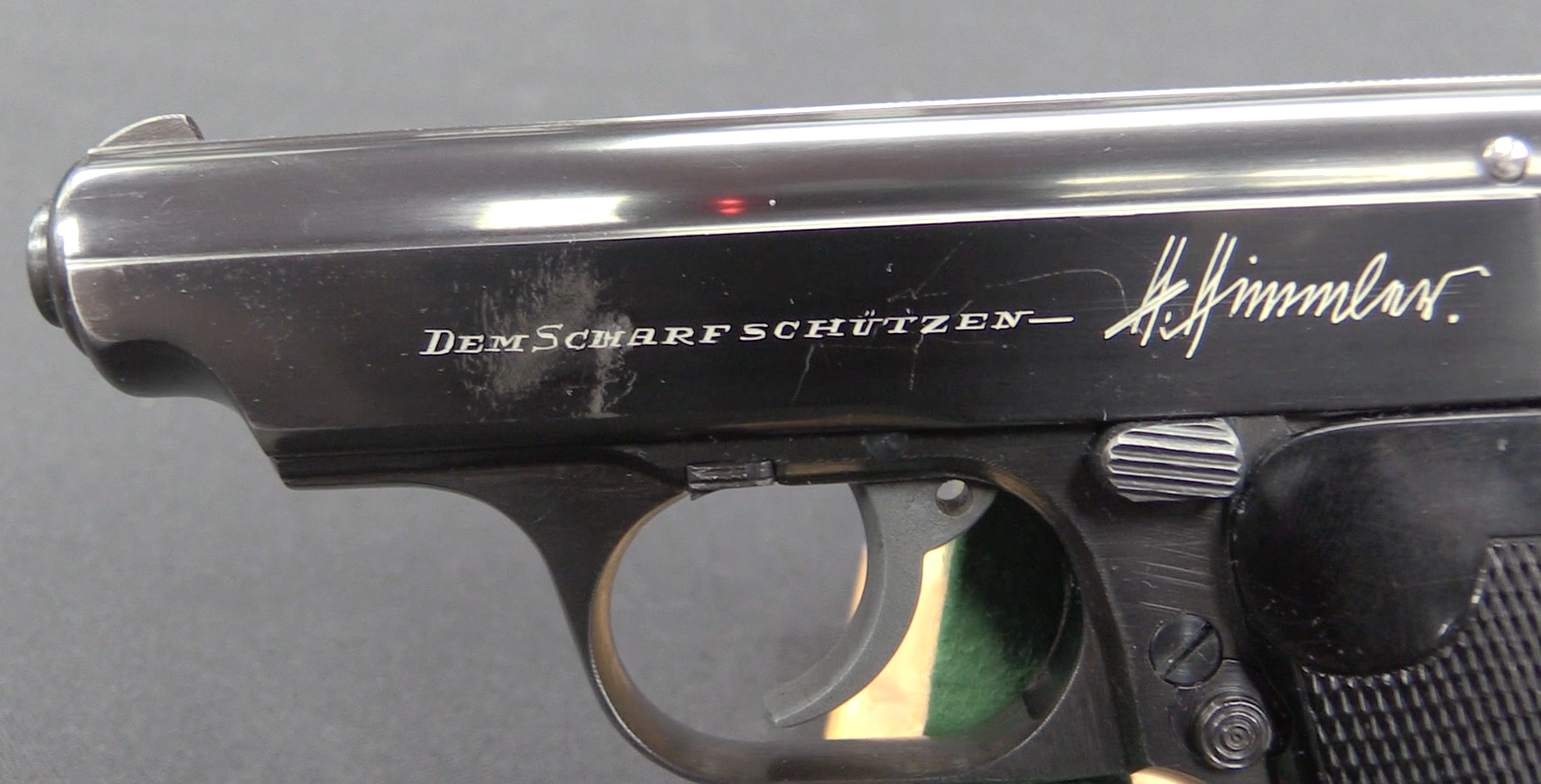The Bergmann #5 was the first pistol in the Bergmann line to have a locked breech action, taken from one of Schmeisser’s machine gun patents. This model was introduced in 1897 using a more powerful cartridge than any of the previous Bergmanns, with the intention of finding military contracts. The new 7.8mm cartridge (actually .30 caliber, same as the 7.63mm Mauser) fired an 85gr bullet at 1300fps, which made it the equal of any other pistol cartridge at the time.
In addition to the more potent round, the 1897 design also replaced the Mannlicher-style clips with detachable box magazines holding 10 rounds. The detachable shoulder stock/holster also became a standard accessory, made for every pistol (instead of an option as on the 1896 models).
The No.5 was tested by Switzerland and England (and possibly other nations) but rejected by both. The English were not satisfied with the caliber (they wanted .45) and the Swiss found it too fragile and unreliable. In total only about a thousand were made.




The English want stopping power and the Swiss want durability and reliability. The former issue is a coconut effect of the black powder era and the latter is from the demanding requirements of a militia-based army which subjects its toys to nasty Alpine conditions and rough treatment by conscripts. What could remedy the latter concern?
“rough treatment by conscripts”
I would say that Swiss conscripts were much more… hmm… “weapon-friendly” (inverse relation to user-friendly) than of other nations.
After all they were one of few users of straight-pull bolt-action repeating rifle (which is more complicated than bolt-action repeating rifle) and probably their usage as default military rifle was longest – others were Austria-Hungary with Mannlicher rifles and (for few years) United States (M1895 Lee-Navy) and Canada (Ross rifle)
Maybe someone with knowledge about condition of surplus military Swiss weapon, will confirm it (by saying that most spotted military Swiss weapons in surplus market are in good condition) or deny it (by saying that most spotted military Swiss weapons in surplus market are in bad condition)
“new 7.8mm cartridge (actually .30 caliber, same as the 7.63mm Mauser) fired an 85gr bullet at 1300fps”
See drawing here: http://www.municion.org/bergmann/7_8x25.htm
notice that it is bottle-neck cartridge, unlike straight-taper of previous Bergmann cartridge. Also notice that there is reported example made by Société Française des Munitions de Paris.
“detachable box magazines holding 10 rounds”
I’m interesting how would be that seen by users (potential and real) back then? Can it be used for marketing as more than most revolvers?
Does Bergmann or anyone else apply bigger magazine for that automatic pistol?
Does any other firm advertise automatic pistol as being more-shot that revolvers in 1890s?
Large capacity does not seem to have been much of a selling point in the civilian pistol market back then. It makes sense, too, because for civilian self-defense purposes 5 or 6 shots is usually plenty at typical pistol ranges. The huge success of the FN/Browning M1900 probably was mostly thanks to compactness compared to pocket revolvers rather than somewhat increased capacity.
There was, however, perceived need for larger capacity and faster reloads in the military market. Innovations such as the Abedie loading gate, break-open and swingout cylinders facilitated faster ejection of empty cases and of course the latter two also enabled use of speedloaders, although they were rarely used at the time. Some 1890s revolvers like the M1895 Nagant and M1898 Rast-Gasser also had a larger than traditional 6 shot capacity. So, on the military market the 10 round capacity would have been a certain advantage for the Bergmann No. 5. The detachable magazine might have also been an aswer to the Mauser c96, which was still clip loaded, but that’s just speculation on my part.
Correction: Abadie loading gate
“The huge success of the FN/Browning M1900 probably was mostly thanks to compactness compared to pocket revolvers rather than somewhat increased capacity.”
I would say that it was achieved by relatively simple construction – according to https://www.marstar.ca/html/other/browning1900assembly.html number of parts was 32
Breveté SGDG breveté Sans Garantie du Gouvernement=> Patented wihtout government guarantee.
This abbreviation, was a legal mention in France releasing the State from any responsibility for the effective functioning of the patented device.
This reference was established by the Law of 1844, which states that patents are granted “without prior examination, at the risk and peril of the plaintiffs, and without any guarantee either of the reality, novelty or merit of the invention, Fidelity or accuracy of description “. This mention disappeared in 1968.
Awesome prestentation anyway, thank you.